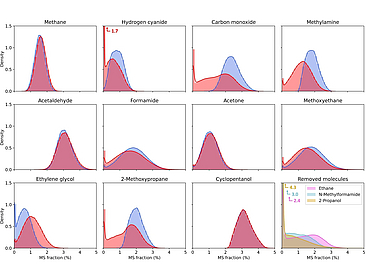Guillaume Leseigneur, Dr. Jan Hendrik Bredehöft, Dr. Thomas Gautier, Dr. Chaitanya Giri, Dr. Harald Krüger, Prof. Dr. Alexandra J. MacDermott, Prof. Dr. Uwe J. Meierhenrich, Dr. Guillermo M. Muñoz Caro, Prof. Dr. François Raulin, Dr. Andrew Steele, Dr. Harald Steininger, Prof. Dr. Cyril Szopa, Prof. Dr. Wolfram Thiemann, Dr. Stephan Ulamec, Dr. Fred Goesmann
Angewandte Chemie International Edition 61 (2022), 29
https://doi.org/10.1002/anie.202201925
The most pristinematerialof the Solar Systemis assumedto be preservedin cometsin the form of dust and iceas refractorymatter.ESA’smissionRosettaand its landerPhilaehad been developedto investigatethe nucleusof comet67P/Churyumov–Gerasimenkoin situ. Twenty-fiveminutesafter the initial touchdownof Philaeon the surfaceof comet67P in November2014, a mass spectrumwas recordedby the time-of-flightmass spectrometerCOSAConboardPhilae.The new characterizationof this mass spectrumthroughnon-negativeleast squaresfittingand MonteCarlo simulationsrevealsthe chemicalcompositionof comet67P. A suite of 12 organicmolecules,9 of whichalso foundin the originalanalysisof this data, exhibithigh statisticalprobabilityto be presentin the grainssampledfrom the cometarynucleus.Thesevolatilemoleculesare amongthe most abundantin the comet’schemicalcompositionand representan inventoryof the first raw materialspresentin the early Solar System.
© The Authors licensed under CC BY-NC-ND 4.0


